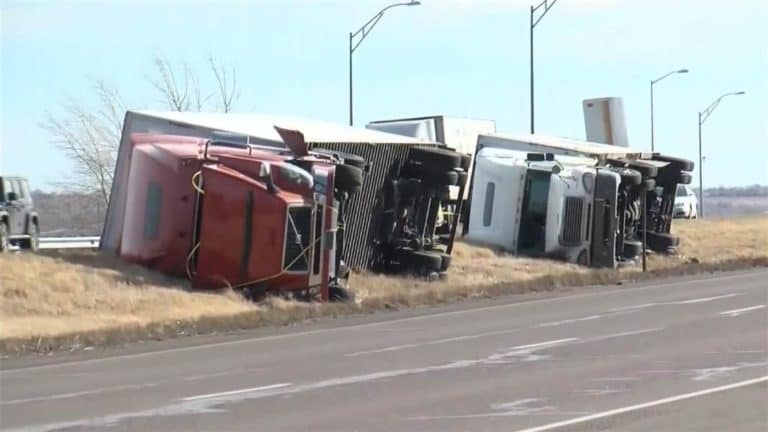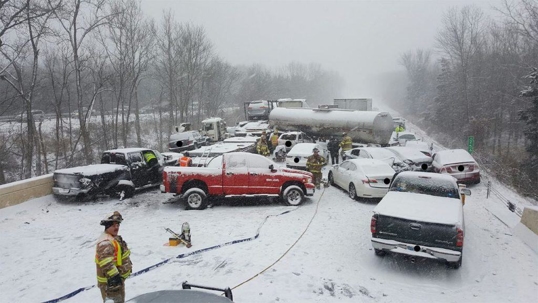Rain, Snow, Fog, Wind: All Drivers Must Be Ready for the Weather
A heavy snow squall. Black ice that looks just like asphalt. Dense fog rolling in from the coast. Rain falling too hard for your windshield wipers to clear.
Drivers in Maine, New Hampshire, and throughout New England understand the weather can change rapidly, making roadways dangerous within a matter of just a few minutes. We also know that even during harsh weather conditions, such as a snowstorm, some drivers will take the risk and keep on driving. No matter the season, weather-related car crashes are common occurrences in our part of the country.
Weather-related crashes range from single-vehicle accidents to chain-reaction pileups like one on the Maine Turnpike on the morning of Feb. 25, 2015. The pileup happened during heavy snow and involved 75 vehicles. Nearly 20 people were injured.
“I’m absolutely shocked that we don’t have fatalities,” one state trooper told the local newspaper. “If Hollywood wanted to create a scene, I don’t think they could have created the amount of carnage that was out there today.”
More than 1 in 5 Crashes Are Related to Poor Weather Conditions
More than 20 percent of all vehicle crashes (car, truck, SUV, other) are related to adverse weather conditions, according to the U.S. Department of Transportation.
The consequences are serious. Each year, nearly 6,000 people are killed and over 445,000 people are injured in weather-related crashes, the DOT reports.
Snow and other winter conditions cause the majority of weather-related car crashes in a few midwestern states. But nationwide – including the states of Maine, New Hampshire, and the rest of New England — rain and wet pavement are the leading culprits.
In Maine, the months of October, November, and December generally see the highest numbers for crashes involving rain and wet pavement. Winter conditions (snow, slush, ice, frost, etc) cause about half of all car crashes in Maine in the months of December, January, and February.
Most Dangerous Conditions Linked to Weather-Related Accidents
- RAIN. An analysis of federal data shows that rain causes more driving fatalities than snow in 39
of the 50 states. Wet pavement and rain were the top two contributors to weather-related automobile crashes
based on the 10-year averages, followed by winter weather hazards and fog. Rain reduces visibility, and wet
driving surfaces reduce vehicle traction and maneuverability.
When a layer of water builds up on a roadway, hydroplaning can occur. Hydroplaning is the term for what happens when a driver attempts to brake, but his or her vehicle continues to slide forward on water, because the tires are not creating friction with the road surface below. Hydroplaning can result in complete loss of control.
- WINTER CONDITIONS. Snow, ice, black ice, sleet, freezing rain, slush. No matter what form it
takes, winter weather conditions pose extreme risks on the roadways.
Light icing events — caused by freezing rain, condensation, or a sudden drop in temperature where the roads are already wet — are considered even more dangerous than snow events. That’s because many drivers stay off the roads during and after a snowstorm. But light icing events catch drivers by surprise. Thin, patchy layers of ice often cause multi-car accidents because an icy road can look exactly like a wet road, until you try to apply your brakes.
- FOG. While fog doesn’t have the same reputation as other types of adverse weather, it should never be underestimated. Fog is related to more than 30,000 car crashes, more than 500 deaths, and nearly 12,000 injuries each year, according to federal data.
Fog is produced by the suspension of very fine moisture droplets in the air. When light hits these droplets, it scatters and results in a loss of contrast and a dense white background. As these droplets get smaller, fog gets thicker. Fog greatly limits visibility, and it distorts a driver’s perception of distance and speed.
- WIND. High winds can diminish the stability of vehicles, particularly high-profile vehicles such as buses, recreational vehicles (RVs), campers, and vehicles towing trailers. Winds can also make roadways hazardous by causing drifting snow, angled rain, dust, smoke, or wind-blown debris including tree limbs.
Winds have a major impact on steering control. Tailwinds push a car forward, headwinds slow a car down, and crosswinds can cause swerving and complete loss of control. Mountain passes, ravines, and bridges are particularly vulnerable to high winds and sudden gusts.
Five Ways to Avoid Weather-Related Car Crashes

1. Stay off the Roads
The best piece of advice is the most obvious one. If you know that the weather conditions are causing the roads to be less safe, then make the smart choice to avoid driving. If the weather changes suddenly while you are already on the road, find a safe place to stop and wait until the situation becomes less hazardous. And if you must drive during harsh weather, slow down and use the utmost caution.
2. If You Must Drive, Go Slow
If you must drive during harsh weather, reduce your speed. The faster you go, the more likely you are to lose control, and the harder it is to slow down and stop. Pay special attention when merging or approaching stop signs and traffic signals. Just because you are driving slowly and with caution doesn’t mean other drivers are doing the same.
3. Keep a Safe Distance from the Vehicle in Front of You
Thousands of car crashes each year, particularly in poor weather, are caused because drivers do not leave enough room between them and the car in front of them. Overestimate the time distance you will need to come to a safe stop.
4. Make Sure Your Vehicle Is Properly Maintained
Small investments, such as new windshield wiper blades, can keep you safe on the roads. Wiper blades, lights, mirrors, and any electronic warning systems are crucial. Make sure you keep up with the basic maintenance recommended by your vehicle manufacturer.
5. Check Your Tires for Pressure and Tread Wear
When it comes to performance on the road in adverse weather conditions, nothing makes more of a difference than your tires. Make sure you are running at the appropriate tire pressure. Have your tires balanced and rotated, and when the treads are worn, replace them.
What Compensation Am I Entitled to as a Car Accident Victim?
Under Maine law, victims of vehicle accidents have the right to recover financial damages for various categories of injuries and loss, including:
- Pain, suffering, and emotional distress, past and future
- Interference with your enjoyment of life
- Medical expenses, past and future
- Time lost from work
- Loss of future earnings
- Damage or total loss of your vehicle

At Berman & Simmons, our legal team has the most experience in Maine handling personal injury claims, including cases involving weather-related car accidents. Our firm will speak with you free of charge about what happened and whether you might have a valid claim.
If we accept you as a client, our lawyers and their teams will investigate. We will interview witnesses, preserve physical evidence and, if necessary, we can even reconstruct the crash to show exactly what happened and why.
Here are some of the reasons why clients choose Berman & Simmons to represent them in personal injury, medical malpractice, and other types of claims:
Results. We have won many of the largest jury verdicts and settlements in Maine history. Two of our landmark cases have been recognized in The National Law Journal’s Top 100 U.S. Verdicts and many of our cases have advanced Maine law to protect the rights of those who have been injured or harmed because of someone else’s negligence.
Reputation. Founded more than 100 years ago, the firm is recognized nationally for its record of success in trials, a fearless approach to litigation, and for standing up for working people against powerful defendants.
Relationships. We care about our clients. We listen. We follow through on our promises. You’ll have a team behind you.
Car accident resources
